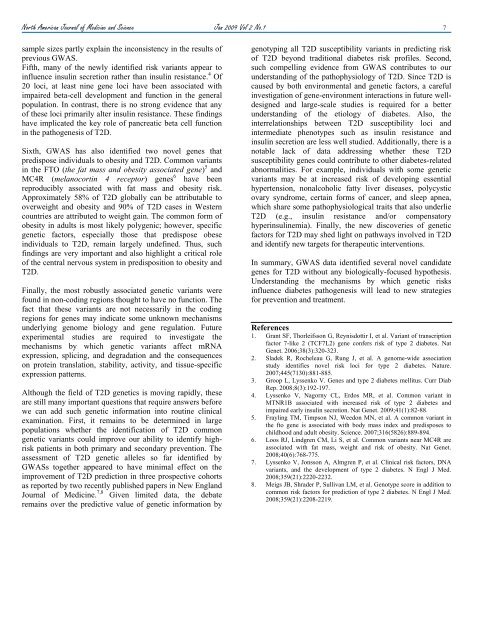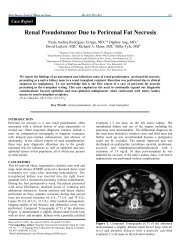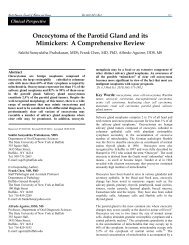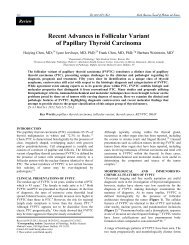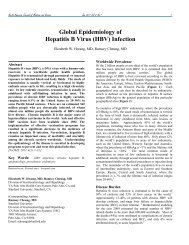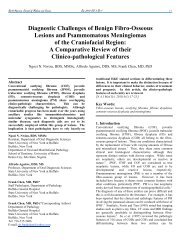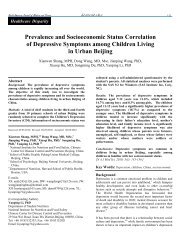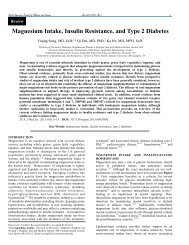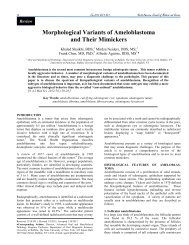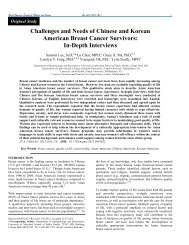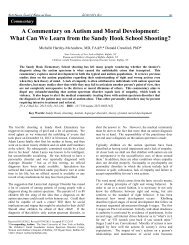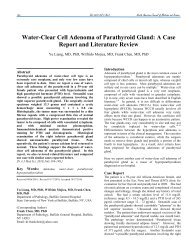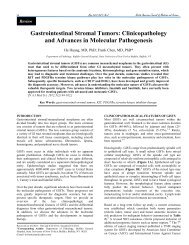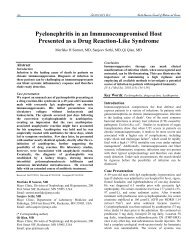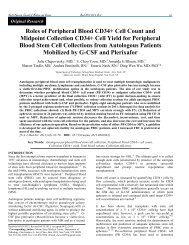Genome-Wide Association Studies (GWAS) Deliver Big ...
Genome-Wide Association Studies (GWAS) Deliver Big ...
Genome-Wide Association Studies (GWAS) Deliver Big ...
Create successful ePaper yourself
Turn your PDF publications into a flip-book with our unique Google optimized e-Paper software.
North American Journal of Medicine and Science Jan 2009 Vol 2 No.1 7sample sizes partly explain the inconsistency in the results ofprevious <strong>GWAS</strong>.Fifth, many of the newly identified risk variants appear toinfluence insulin secretion rather than insulin resistance. 4 Of20 loci, at least nine gene loci have been associated withimpaired beta-cell development and function in the generalpopulation. In contrast, there is no strong evidence that anyof these loci primarily alter insulin resistance. These findingshave implicated the key role of pancreatic beta cell functionin the pathogenesis of T2D.Sixth, <strong>GWAS</strong> has also identified two novel genes thatpredispose individuals to obesity and T2D. Common variantsin the FTO (the fat mass and obesity associated gene) 5 andMC4R (melanocortin 4 receptor) genes 6 have beenreproducibly associated with fat mass and obesity risk.Approximately 58% of T2D globally can be attributable tooverweight and obesity and 90% of T2D cases in Westerncountries are attributed to weight gain. The common form ofobesity in adults is most likely polygenic; however, specificgenetic factors, especially those that predispose obeseindividuals to T2D, remain largely undefined. Thus, suchfindings are very important and also highlight a critical roleof the central nervous system in predisposition to obesity andT2D.Finally, the most robustly associated genetic variants werefound in non-coding regions thought to have no function. Thefact that these variants are not necessarily in the codingregions for genes may indicate some unknown mechanismsunderlying genome biology and gene regulation. Futureexperimental studies are required to investigate themechanisms by which genetic variants affect mRNAexpression, splicing, and degradation and the consequenceson protein translation, stability, activity, and tissue-specificexpression patterns.Although the field of T2D genetics is moving rapidly, theseare still many important questions that require answers beforewe can add such genetic information into routine clinicalexamination. First, it remains to be determined in largepopulations whether the identification of T2D commongenetic variants could improve our ability to identify highriskpatients in both primary and secondary prevention. Theassessment of T2D genetic alleles so far identified by<strong>GWAS</strong>s together appeared to have minimal effect on theimprovement of T2D prediction in three prospective cohortsas reported by two recently published papers in New EnglandJournal of Medicine. 7,8 Given limited data, the debateremains over the predictive value of genetic information bygenotyping all T2D susceptibility variants in predicting riskof T2D beyond traditional diabetes risk profiles. Second,such compelling evidence from <strong>GWAS</strong> contributes to ourunderstanding of the pathophysiology of T2D. Since T2D iscaused by both environmental and genetic factors, a carefulinvestigation of gene-environment interactions in future welldesignedand large-scale studies is required for a betterunderstanding of the etiology of diabetes. Also, theinterrelationships between T2D susceptibility loci andintermediate phenotypes such as insulin resistance andinsulin secretion are less well studied. Additionally, there is anotable lack of data addressing whether these T2Dsusceptibility genes could contribute to other diabetes-relatedabnormalities. For example, individuals with some geneticvariants may be at increased risk of developing essentialhypertension, nonalcoholic fatty liver diseases, polycysticovary syndrome, certain forms of cancer, and sleep apnea,which share some pathophysiological traits that also underlieT2D (e.g., insulin resistance and/or compensatoryhyperinsulinemia). Finally, the new discoveries of geneticfactors for T2D may shed light on pathways involved in T2Dand identify new targets for therapeutic interventions.In summary, <strong>GWAS</strong> data identified several novel candidategenes for T2D without any biologically-focused hypothesis.Understanding the mechanisms by which genetic risksinfluence diabetes pathogenesis will lead to new strategiesfor prevention and treatment.References1. Grant SF, Thorleifsson G, Reynisdottir I, et al. Variant of transcriptionfactor 7-like 2 (TCF7L2) gene confers risk of type 2 diabetes. NatGenet. 2006;38(3):320-323.2. Sladek R, Rocheleau G, Rung J, et al. A genome-wide associationstudy identifies novel risk loci for type 2 diabetes. Nature.2007;445(7130):881-885.3. Groop L, Lyssenko V. Genes and type 2 diabetes mellitus. Curr DiabRep. 2008;8(3):192-197.4. Lyssenko V, Nagorny CL, Erdos MR, et al. Common variant inMTNR1B associated with increased risk of type 2 diabetes andimpaired early insulin secretion. Nat Genet. 2009;41(1):82-88.5. Frayling TM, Timpson NJ, Weedon MN, et al. A common variant inthe fto gene is associated with body mass index and predisposes tochildhood and adult obesity. Science. 2007;316(5826):889-894.6. Loos RJ, Lindgren CM, Li S, et al. Common variants near MC4R areassociated with fat mass, weight and risk of obesity. Nat Genet.2008;40(6):768-775.7. Lyssenko V, Jonsson A, Almgren P, et al. Clinical risk factors, DNAvariants, and the development of type 2 diabetes. N Engl J Med.2008;359(21):2220-2232.8. Meigs JB, Shrader P, Sullivan LM, et al. Genotype score in addition tocommon risk factors for prediction of type 2 diabetes. N Engl J Med.2008;359(21):2208-2219.


